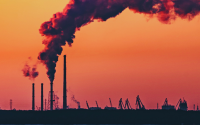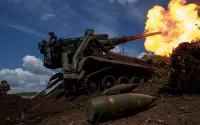6 February 2005Peter Wardseatllepi.com
In his masterpiece novel, "The First Circle," Alexander Solzhenitsyn wrote about the nightmare that was Stalinist Russia in the 1950s, a time of purges and terror. I read this novel in 1968, during the height of the Vietnam War, while I was a freshman at the University of Washington, and I remember a memorable passage in which Solzhenitsyn accurately noted that the vast majority of scientists in Russia at that time were paleontologists.
Apparently studying the past was a better elixir for escaping the present than any drug, and it was clear that the great Nobel laureate viewed paleontologists as perhaps the least relevant scientists on the planet -- intellectuals who had knowingly chosen a field of absolutely no interest or use to that totalitarian state.
Having already decided to make the study of paleontology my career when I read this novel, I, too, wondered about my relevance to society (but certainly appreciated the way that paleontology could indeed take one's mind off a brutal and dangerous present). More than 35 years have passed since then. Armed with the fabulous education that I had received in Seattle's public schools and the University of Washington, I did succeed in making a living out of studying the past, and have even returned to take the position of my old research professor at the UW.
Over my career, I have watched my field flourish and provide incontrovertible evidence that evolution, a scientific principle that for unclear reasons still causes great insecurity to many fundamentalist Christians, is a fact. For this reason alone, it is clear that paleontology is not as irrelevant as averred by Solzhenitsyn.
In fact, new findings that I helped gather, and very recently published in Science magazine, may offer key clues and information sorely needed by policy-makers in at least one other hot-button topic: global warming. Is there a threat to biodiversity in the current rise in global temperature caused by the greenhouse gases that humans have produced? It turns out that paleontology has much to offer in answering this question.
Our work has shown that the greatest mass extinction in all of Earth's history was caused at least in part -- perhaps in largest part -- by an ancient episode of global warming. There were certainly no smokestacks, or sport utility vehicles, about 250 million years ago, when the world underwent a cataclysmic mass extinction that has come to be known as "The Great Dying."
But a cataclysmic outpouring of volcanic lava ultimately covered a third of the land area of Siberia, causing enormous quantities of carbon dioxide gas to enter the atmosphere at the end of the Permian Period. Because of increased atmospheric CO{-2} from this prolonged volcanic episode, the Earth warmed very quickly: so quickly, in fact, that the plant life of the time could not disperse or evolve for warmer conditions rapidly enough to ensure survival.
As plants died, animals soon followed. This cataclysm stretched on for millions of years, but it had its greatest concentration of heating during an interval of 10,000 years or less, and by the end, more than 80 percent of all life on Earth had gone extinct. And this extinction was not unique. In rocks of about 60 million years in age (and in rocks of 110, 125, 175, 201, 214, 227 and 250 million years in age), a great death of species is recorded.
Much new information about these mass extinctions tell us the cause: Each appears to have been associated with elevated atmospheric levels of carbon dioxide, causing a rapid rise in global temperatures. The higher temperatures caused plant death and ecosystem disruption, leading to widespread species extinction among both vertebrates and invertebrates. I can show that at least 11 times in the past 250 million years, bouts of global warming have produced successive mass extinctions -- two in the late Permian Period, three in the Triassic, two in the Jurassic, two in the Cretaceous and two in the Tertiary. A new paradigm is now apparent: Global warming has thus caused the majority of mass extinctions in our planet's past, including the most catastrophic of them all, the Permian mass extinction.
Today we are also in a period when rising rates of carbon dioxide are rapidly warming our world. Could this also cause a mass extinction? Probably not, at least on the scale of the Permian extinction. Our plants are better adapted for change, and ecosystems of the modern world may be more resilient than those of a quarter-billion years ago in the face of global warming.
Thus, while most of us who study past catastrophes believe that we are not facing a new mass extinction comparable to that of the Permian, this does not mean that we are not at some risk from the natural gases that we are unnaturally spewing into the atmosphere. While most plants are resilient, many of the species making up important agricultural crops are not. We absolutely depend on bumper crops to feed the ever-more human mouths that each new year brings. Global warming can, and probably will, perturb patterns of temperature and rainfall in critical agricultural regions, such as the American Midwest and the vast steppes of central Russia, regions that are essential for the production of wheat and other grains necessary to feed 6 or more billion humans. While we cannot yet predict whether the changes now occurring will make matters better or worse for crop yields, can we really afford to gamble our future by doing nothing?
The Permian animals could do nothing about their volcanoes, and they mostly died out. But we can -- and must -- do something about the equivalent sources of greenhouse gases in our time. As China and India enter the Automobile Age, our time for action grows ever shorter. Our more recent climate has been the alteration between glacial and interglacial, with the tropics now inhabiting a relatively narrow band at low latitudes, rather than the nearly pole-to-pole tropics of the late Permian world. But for how much longer?
The production of greenhouse gases by human activity is changing the climate. We are specifically returning to an Eocene climate, the time 60 million years ago when palm trees, now seen in the rocks on Chuckanut Drive, grew in what is now Bellingham, a time when there was no polar ice. The Eocene world was so much warmer because it had higher CO{-2} values. At the rate of current rise of CO{-2} caused by human as well as natural causes combined, we will be at the same level that created the temperatures allowing Eocene palm trees in Washington in less than a century. Our future appears to look like our past. While having palm trees might be nice, having the tropical diseases, such as malaria that is the scourge of warm regions, may not be so nice.
Last week, as news reports of our paleontological findings began to circulate, I was amazed at the outpouring of questions from ordinary citizens who are worried about this issue. But I was alarmed as well at the number of telephone calls and e-mails dripping with hostility toward anyone who would even suggest that global warming is both real and a potential danger to our society and civilization. Global warming will not go away. At this point we can at best blunt the damage, but doing nothing may lead us to catastrophe, especially if the swell of human population is met by a downturn in global food production.
While paleontologists have entered the arena of relevancy in this new century, unfortunately it is now our political leaders who are stuck back in the 1950s.
Alexander Solzhenitsyn wrote of a "first circle." I am afraid that we have come full circle, re-entering a world like that of 250 million years ago -- but a world in which the leader of the greatest producer of greenhouse gases -- and thus global warming -- prefers obfuscation to the unfortunately expensive but necessary confrontation of a potential global killer. History may judge George W. Bush far more harshly for what he did not do than for what he did.






